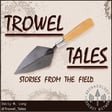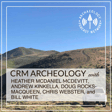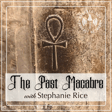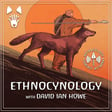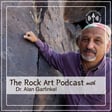Become a Creator today!Start creating today - Share your story with the world!
Start for free
00:00:00
00:00:01

Favorites in Archaeology - Episode 5
On this episode, we're keeping things lighthearted. Listen to archaeologists' favorite artifacts, archaeological sites, places, and experiences in the field and how hard it can be to choose just one. For a lot of archaeologists, it's not just about the stuff. It boils down to the love of discovery and recording the past for future generations.
Transcript
Introduction to Archaeology Podcast Network
00:00:00
Speaker
you are listening to the archaeology podcast network the archaeology podcast network is sponsored by codify a california benefit corporation visit codify at www.codifi.com
Theme: Lighthearted Archaeology Stories
00:00:29
Speaker
Welcome to another episode of Trial Tales. On this episode, we're keeping things light-hearted by sharing stories about our favorites, favorite artifacts, archaeological sites, and so on.
00:00:43
Speaker
For me, it's hard to pick one place or one amazing artifact. Archaeologists can go to field school anywhere in the United States, or the world for that matter. Then, at least in CRM and federal work, archaeologists get to survey and excavate places the public rarely gets to see. For example, I got to survey parts of the Pacific Crest Trail going up and over mountains, but I've also been able to excavate and study all over the world.
Experiences in Hawaii: Landscapes and Sites
00:01:11
Speaker
there simply is too much to choose from. But every archaeologist has at least one favorite out of many. When I was asked to talk about my experiences as an archaeologist, I was instantly drawn to it because archaeologists live fascinating lives.
00:01:40
Speaker
I guess I can vouch for that. Over the past 10 years, I've worked and lived on numerous continents and states, including Guam, Saipan, California, Arizona, Utah, and Pennsylvania. I've slept in the company's office, hotel rooms, camped, and stayed at youth hostels, all in the name of archaeology.
00:02:05
Speaker
I roughly define archaeology as the pursuit of understanding the past to inform the present. And the way we can learn about the past are through the things that are left over from the passage of time. So therefore, archaeologists study things that were created in the past in order to inform the future.
00:02:27
Speaker
I work on the Big Island of Hawaii. Probably my favorite thing about the Big Island is all the different landscapes and environments. You know, you drive to one side of the island, there are all the volcanic rocks, and it feels like you're on the surface of the moon. Then you drive to the other side, and there are rainforests and waterfalls, and it's probably one of the most beautiful places on Earth.
00:02:50
Speaker
And when I'm working, I get to explore and study these landscapes. It's one of the most extreme and beautiful places I've ever worked. Most of the archaeological sites are in incredibly remote areas that are hard to access. The lava flows are sharp, and if you fall, they can mangle you. Growing up in the frontier west in Wyoming, dealing with extreme weather and landscapes has really helped me with this variable.
Historical Layers in Hawaii: Preservation Responsibility
00:03:17
Speaker
Some of the big archaeological questions on the Hawaiian Islands revolve around the peopling of the Hawaiian Islands in the past. So you have to start asking yourself, why would people essentially come to the Hawaiian Islands and how did they find them? How did they get here? What kind of factors would drive a group of people to essentially move to this uninhabited island that we now call Hawaii?
00:03:47
Speaker
And with this movement of Native Hawaiians, they brought with them cultural ideas about how to survive. And they brought different things to Hawaii that we can still see today, like the banana plant and the taro and all these beautiful Hawaiian plants that were incredibly important to the Native Hawaiians when they first came to this place.
00:04:14
Speaker
Later in time, James Cook came to the big island of Hawaii at Kealakee Kua Bay and really marked the beginnings of a time of dramatic cultural change in Hawaii.
00:04:27
Speaker
There was a lot of people that ended up coming to Hawaii for various reasons, including agriculture, the missionaries, ranchers, and even the military came out here. So what's unique about working in Hawaii is that it's an incredibly complex tapestry of time.
Community Involvement in Hawaiian Archaeology
00:04:48
Speaker
where you have all these different types of time periods that are essentially interwoven together and exist on top of each other. For example, you'll have an area that was used by native Hawaiians for agriculture, and then later on it was used for sugar cane, and then later on it was used for ranching, and now currently it's used for a military training on a base.
00:05:14
Speaker
So the role of the archaeologists is in order to figure out the past. We need to make really good research ideas and try to piece together the past. And whether it be looking at a mound of rocks,
00:05:29
Speaker
and deciding if it's either ranching or something that the military made, these are important things. I consider my job sacred in Hawaii because these decisions ultimately impact the future of Hawaii.
Unexpected Archaeological Discoveries
00:05:43
Speaker
Unfortunately, there's an incredibly rich oral tradition and Hawaiian activist movement that helps out and augments the archaeological interpretations.
00:05:55
Speaker
And in Hawaii, a community-based archaeology is a huge part of the future. So as an archaeologist working in Hawaii, I have a lot of responsibility in order to help make informed decisions for the future. And this makes my job incredibly important.
00:06:21
Speaker
at Wide Ruins, that was pretty amazing. There was like a Kiva, that was I think two feet deep or something like that, or no, not two feet, two meters deep. That was pretty cool. I mean, there was one guy on the crew who's...
00:06:35
Speaker
incredibly tall and I mean some people they'll know exactly who I'm talking about but you could he's about six seven or so and you could just barely see the top of his head when he was standing in it so that was a really cool site just in general like there was room blocks with slab floors and when you work down in Phoenix Basin with like pit houses with earthen floors and then you go up north and excavate actual slab floors it's like you know you got a floor
00:07:05
Speaker
That's kind of a fun experience when, as opposed to just like, is it floor or is it not floor? I mean, when it's so ephemeral down here. We did have some pretty cool stuff at this last project, some really cool pit houses, like one that had a really good plaster floor where you could actually see it coming up the walls. Like, I was monitoring the backhoe when we hit it and it looked almost like a really
00:07:30
Speaker
long shard that was vertical in the ground. But no, that was like wall that we hit. So that was really fun. I'd never seen anything like that before. All right. My favorite site, it's actually a series of sites.
00:07:51
Speaker
I was doing a recordation of the Santa Fe Trail. And as we were coming down, we knew that from some of the aerial photography that we looked at for trying to find the route that we wanted to survey became what looked like a Pueblo, which doesn't really make sense in that area. And it turned out when we came on it, it was actually a stage stop that was associated with the Santa Fe Trail.
00:08:19
Speaker
So that was pretty cool. That was neat. But what was really neat and what was interesting about it is on the other side of the drainage was a Plains Native American site that had multiple stone circles for some kind of structures as well as rock art panel and a large lithic scatter. So you have this really neat area where you can see multiple use over the course of probably
00:08:47
Speaker
hundreds of years and just in one small little drainage. So that would be my favorite site.
00:09:00
Speaker
One of the things that I always talk about when people ask what's the coolest thing you've ever found is digging up in Canada at a kind of contact period in a wet sod house. So we were expecting to find some stoneware and nails from floorboards.
00:09:21
Speaker
things that are relatively modern in the archaeological record. And as we're digging, we're finding all these flakes from stone tools that don't really seem to come from the period that we're
00:09:41
Speaker
interested in, and they don't look like they've been modified either. It doesn't look like somebody is picking something up off the ground and saying, well, I can change this to make it more useful for what we're doing today. And over the course of about a week, the crew found 10, 10 plus of these, these things are beautiful.
00:10:06
Speaker
museum quality, you know, arrowheads and knife blades and just beautiful, beautiful, beautiful pieces, including one that I had found the third or fourth day we were there. And it was a blade for a knife that looks like it was somewhere between four and 6,000 years old, just based on the napping style of that particular blade.
00:10:35
Speaker
And it was just really interesting because this wasn't a site that we were expecting to find anything super old. The site had been identified in the 1960s as the site of a contact period, a group of three houses. And that's really all we were expecting. And all of a sudden, we're finding all of this really, really old stuff. And we found some modern stuff
00:11:04
Speaker
but really not a lot. They'd done a really good job cleaning out or hadn't been there for so long.
Nature's Beauty in Archaeological Surveying
00:11:16
Speaker
The interpretation is still underway. Oh, wow. Actually, it was a fairly recent experience.
00:11:27
Speaker
I don't think that there's any plans to go look at the other two houses to see if they can shed more light. It's a difficult part of the world to excavate in. But it's always really interesting when you find really anachronistic things like that. And then a portion of the house that we were doing two by twos for, we got down to the cultural level and I was seeing this kind of dark,
00:11:56
Speaker
staining looking in the soil. So I decided to dig down a little bit below what had been sterile in three out of the four quadrants of the two by two and actually found what looked like a fire pit with a whole bunch of charcoal in it. But it was, there was still a layer of sterile between that and what we were looking at for the contact period.
00:12:26
Speaker
So, you know, then you end up with questions of, did the people who built that house realize that that fireplace was there? I mean, there wasn't very much of a covering over it. Did they not realize that it was there? And then there were a bunch of micro blades around that, which is also an older style of flint knapping. So just the layers of occupation, we really weren't expecting it. It was super fascinating.
00:13:00
Speaker
Well, my favorite moments during survey, because I mean, I prefer survey to excavation. My favorite moments during survey are those feelings when you are 700 miles away from home and you're on a mountainside.
00:13:19
Speaker
a tree line in your... you can't see your crew. You're the only one, you know, that you're aware of. It doesn't have to be archaeology per se, but you're really in the middle of nowhere. And regardless of whether or not someone has actually stepped there before or not, which in all likelihood someone has, regardless of that, your
00:13:43
Speaker
humbled by the like power and
00:13:51
Speaker
scope of nature of your observable universe. I mean, looking out over just hundreds of miles is one of the most awe-inspiring, beautiful feelings that I feel like most people on a day-to-day basis don't even understand. I mean, I'm not fortunate enough to have
00:14:14
Speaker
archaeology work in the off-season. So, like a lot, a lot of people, you know, so I'm a, you know, I work at a music venue. And no one, no one, no one outside of field work, and I'm not just saying archaeologically, I mean, biologists, geologists, whatever, but no one outside of what we do really understands what it is or why. And when I started, it was because I thought it was cool and because
00:14:41
Speaker
I wanted to really stereotypically fortune and glory and published and write books. Then I found myself in places that are just so remote that most people who claim to be outdoor enthusiasts wouldn't be able to make it to.
00:15:10
Speaker
It's awe-inspiring and it's hard to relate that to people with big open sky overhead and mountains underfoot.
00:15:21
Speaker
Yeah, that's my favorite part. Those are some of my favorite moments on survey. I mean, there's always the satisfaction of cutting out into a clearing and there's just flakes, you know, or one, that one flake or that one point, you know, the last project I was on was outside the towels. And I found the only point on the project, like the whole project. And I, you know, it was satisfying and cool, but
00:15:50
Speaker
I forgot about it a day later, you know, next thing I know, the best thing for me is being at the highest point in the survey area and looking out over the mountain range. I'm on it. Yeah. You know, that sort of stuff is good. Like being good at what you do is good, but like feeling humbled by nature, you know, feeling like you could have a beer with John Muir is pretty cool.
Ad Break: Digital Training for Cultural Management
00:16:23
Speaker
Let's take a quick break.
00:16:35
Speaker
At digitaltraining.site, we believe that spending money on learning is great if it helps you solve a problem. If you're a cultural resource management professional, you want to make your workflow faster and more efficient to beat your competitors. If you're a student or young professional, you'll want to learn marketable skills to get that job. If you're a faculty, you want to stay up to date with teaching topics.
00:16:53
Speaker
But you feel overwhelmed by all the technologies and tools out there. digitaltraining.site is for you. You'll get relevant topics by top-level instructors and downloadable materials at an affordable cost. And if you're an enrolled student, apply for a scholarship and attend for free. Start learning now at digitaltraining.site.
00:17:21
Speaker
Welcome back. We'll continue with stories of our favorite things in archaeology.
Intriguing Finds: Ritual Activity in Illinois
00:17:34
Speaker
Okay, so I was working on a middle living burial mound in Illinois on a field school and we weren't excavating human remains. We were looking at the southern end of the
00:17:47
Speaker
of the mound. The mound is called Mound House and there's actually a very nice monograph that was put out by Jane Bykstra and Doug Charles about the site. There was a few years of excavation there. So one day we dug in two by twos, two meter by two meter units. So we had a fairly big area to excavate for a two person team.
00:18:16
Speaker
And so we were shovel scraping with a flat, a big flat shovel. You know, two by two is a big area. So we were just kind of peeling off shovel scrapings. And the dirt was kind of a dark brown, kind of rich organic soil on the floodplain of the Illinois River. And so we were
00:18:38
Speaker
shovel scraping along and I threw a shovel full of dirt in the screen and my dig partner who's screaming said whoa that's yellow and so we stopped and and we scraped down the unit with our trowels and sure enough there were four yellow kind of circularish blobs in an arch
00:19:02
Speaker
across our unit. I'm like, well, that is strange. And so we scraped those down, and then we realized that they were probably post molds. And we cut one in half. We excavated half of one. And sure enough, they were post molds filled with yellow soil.
00:19:28
Speaker
And so the post didn't rot in place. What happened was the posts were pulled and the yellow soil was put in the holes where the posts were. So there was an arc of these and you could theorize that it actually was a circle at the southern end of the mound.
00:19:49
Speaker
and that there was some kind of ritual activity there because there were four layers of different yellow soils in the bottom of one of these postholes. So it was full.
00:20:02
Speaker
And then below that, the soil that filled the post mold, below that there were three other different kinds of soils that buried in color and texture. And so they had repeatedly done this. They had put a post in, pulled it out, filled it with yellow soil, dug out yellow soil, put in a new post. And so they had done that three times. Well, some kind of ritual activity, not really sure
00:20:31
Speaker
you know, what kind of ritual, maybe it was a burial ritual, you know, maybe it was, it was a burial mound. So that's kind of a, you know, a realistic, logical assumption that it was some kind of burial ritual. Now the timeframe between the setting of the post and the pulling of the post and then redoing it is, you know, up for
00:20:57
Speaker
speculation whether it was a yearly occurrence or whether it happened when a certain type of person died or, you know, when, you know, who knows. But it is clear evidence of ritual activity at a burial mound location.
Tensions of Exploration: Belize Cave Artifacts
00:21:24
Speaker
You know, it's an interesting question. I do have an answer, but I'd first like to say when you're a CRM archaeologist and you're just doing this, whether you're excavating or surveying all year long, and I've been doing this 11 years now.
00:21:36
Speaker
The coolest thing really kind of comes down almost to a daily or weekly basis, not like a lifetime basis because you could be walking out there and not find anything for days and days and days out here in the high desert. And then all of a sudden you find this broken little projectile point. Well, that just became the coolest thing I've ever found because I haven't seen anything in so long.
00:22:01
Speaker
I don't know, I feel like most archaeologists would have a hard time picking a favorite. One of, I'd say the coolest thing, the coolest place I found was a Maya site inside of a cave in Belize and it was while I was on survey, me and this small crew had been hiking around
00:22:23
Speaker
in the jungles and we stopped in this small town and there was this little like kind of convenience store general store kind of thing in the town and uh popped in there and i was just asking about land ownership and stuff um because we had a permit from the government to to go onto anybody's private land but just as
00:22:44
Speaker
you know, just to be polite and not, you know, enrage the, you know, local residents, I would just go and check around and be like, hey, I want to go up here. Do you know who owns it? You know, if I could track them down, you know, because with it, with those kind of communities, basically everybody knows everybody and
00:23:05
Speaker
If that person isn't there then they usually know how to get in touch with them so I'm going around and they're like yeah and also when I'm doing stuff like that they usually readily volunteer information about cool sites.
00:23:21
Speaker
And so they're like, oh, yeah, there's this cave up there up on top of this big hill. You should go up there. And I was like, if you if if you're free, could you could you show me? He was like, yeah, there's and so this guy goes up there and shows me he didn't want to go in. He he was like, no, sometimes cows wander in there and they die. You know, I don't want to go in there. And so I popped down in there.
00:23:47
Speaker
And I'm poking around and I see like limestone blocks that are, you know, they're filthy, they're covered in all sorts of, you know, collapse and soil and plants and stuff. And I'm like, something looks different about this. And I had this headlamp in my backpack that I hardly ever used because I was always on the surface. And so I pull it out and I'm shining around and I'm like, this is architecture.
00:24:13
Speaker
inside a cave, and that's weird. And so I pop back out, tell my crew, and they're like, what, really? And I'm like, yeah. And so we pop back down in there, and they come in, and one of them sees a big ceramic vessel. Okay, well, let's get out of here. And the guy, like, because we had to be so careful about looting, and it's one of those things, like, the guy knew there was a site in there,
00:24:43
Speaker
And so there's no point in lying to the guy and being like, oh, well, we didn't find anything. So we go, oh, yeah, sure enough, there's a site. Thank you so much for telling us that. And so we got his information, wrote it down and all that so we could credit him in the report.
00:24:59
Speaker
and we went on and it's one of those things where like you see that and it just kind of blows your mind that you see it and it's like creepy but also awesome at the same time and it's it's one of those things that I wish I could go back but that just wasn't part of my scope of work you know is like my scope of work was just do the survey identify sites record as much as I could to
00:25:21
Speaker
you know, assess the research value so that teams in the future could go back and do research on them.
Adventurous Archaeology: Helicopter Assessments
00:25:28
Speaker
And so that was one of those moments too where it was like early on I was learning about scope of work because I just wanted to abandon survey and go work in this cave. And they were like, no, there's still so much survey for you to do. So I had to keep surveying.
00:25:52
Speaker
It's really hard for me to choose just one favorite artifact, excavation, area to excavate, or coolest experience, but I can easily say that my favorite thing about archaeology as a whole
00:26:03
Speaker
is how you can have many different roles as an archeologist. Get to wear many different hats, so to speak. When I worked for the park service, part of my job was protecting archeological sites from wildfires. One of my favorite experiences while doing fire archeology was being flown by helicopter to a remote wildfire, an area middle of nowhere, to assess the archeological sites out there.
00:26:31
Speaker
It was just simply too far to hike to this wilderness area and that was most of the time with wildfires time was of the essence. We had to get out there. I had never been in the helicopter before and this seemed like it was going to be my most like Indiana Jones-ish adventure-like moment. I mean how many people can say they just they have to be flown via helicopter
00:26:58
Speaker
in the pursuit of archaeology. It kind of blew my mind and to tell the truth I was a little freaked out too. I was given very little notice and I had to do some quick online training, you know, like on how not to die while in a helicopter getting in and out of the helicopter.
00:27:17
Speaker
and i think it was the next day that i met with the fire helitech crew was given a flight suit and popped in the helicopter with uh i think two other uh fire guys and just getting up in the air we got to fly over these rolling hills and
00:27:38
Speaker
um mountains and got to see these beautiful meadows and it was just amazing that view i had never been up that high other than you know in an airplane and so you're not too far off the ground you could really see why people would want to be in that area um both in prehistoric and historic times i mean there's just an incredible beauty um you could see the resources and just be able to see that from
Sensory Experiences: Understanding the Past
00:28:07
Speaker
a bird's eye view was absolutely amazing.
00:28:19
Speaker
Well, something that immediately comes to mind, it connects back to that really just lovely field school experience that I had. I was excavating a hearth on a beach, right, hearth on a beach and came across a turtle shell that was like in the hearth and perhaps this turtle had been cooked. It was very cool.
00:28:57
Speaker
has just been places that other people haven't gone in a very long time. I'm certainly not discovering anything new when I've been surveying usually because we were really doing site revisits.
00:29:02
Speaker
And of course, I've never come across anything like that in the Southwest.
00:29:17
Speaker
there was always that personal sense of discovery as you round a bend or climb up on top of a beaut. You know how, I don't know if you do this, but whenever I am walking around this landscape, if I see a high place, I just have to go and see what's up there.
00:29:34
Speaker
And it's that sense of discovery. When you go up and find out what's up there, find out, you know, were people living up there? Did they build some sort of defensive structure? Was there a tower? What's the visibility from those places? That's one of the things that I love looking at across this part of the Southwest is just what you can see from where, because you can see so much.
00:29:59
Speaker
And to me, you can tell a lot about what people found to be important, whether it was keeping an eye on their neighbors or being able to see important mountains or mountain ranges on the horizon. You can really get a sense of what was important by going to those places and taking in
00:30:22
Speaker
this sort of sensory experience of being there. And that I think is one of the, if I had to nail down something, I know it's ephemeral, but something that I really enjoy discovering, it's not necessarily the objects, but it's the sensation of being in some of these places.
00:30:46
Speaker
There are so many amazing things we find and experience in archaeology. But as I hope these stories demonstrated, it's not just about the stuff, the artifacts, or huge archaeological sites.
Conclusion and Listener Engagement
00:31:00
Speaker
It's the love of discovery, being at beautiful locations, and protecting and preserving the past.
00:31:13
Speaker
Special thanks to Jesse, Carrie, Mike, Chelsea, Chris, another Chris, David, Kristen, and Kyle for contributing their time and stories. Music was created for this podcast by Tristan Elliott.
00:31:29
Speaker
Check out the podcast on Facebook and trialtales.com to learn more about the podcast and let us know what kind of stories you'd like to hear. Also, if you're an archaeologist and would like to contribute a tale or two, send a message to trialtalespodcast.gmail.com. Until next time,
00:31:51
Speaker
This has been a presentation of the Archaeology Podcast Network. Visit us on the web for show notes and other podcasts at www.archaeologypodcastnetwork.com Contact us at chrisatarchaeologypodcastnetwork.com
